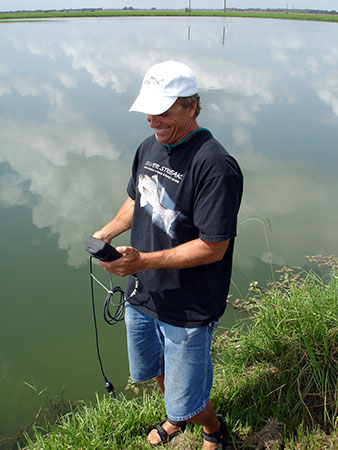Water Quality Meter Saves Valuable Time
With 110 ponds and nearly 1,000 acres of water spread across two farms, the production team at Silver Streak Bass Co. near Danevang, Texas has a lot on its mind. The pressure is high in an operation that produces premium-quality hybrid striped bass, a fish that’s very expensive to produce and therefore very costly to lose. And the pressure is even higher when ammonia levels rise before Nitrosomonas bacteria populations can catch up and detoxify the water supply.
Ammonia is extremely toxic to fish, even at extremely low concentrations. (Learn more, Pond Based Aquaculture | Understanding Ammonia).
Fish continually excrete ammonia through their gills, as well as in their urine. In the confines of aquaria and ponds – especially when weather conditions favor high feed intake and rapid fish growth – ammonia levels can rapidly rise to dangerous levels unless it is removed through biological filtration or dilution through water exchange.
Silver Streak has freshwater wells that it uses for water exchange. As ammonia levels climb in the ponds, farm manager David Maus is in a race against time to pump in new water and save the fish.
“The key is to target your water to where you have a problem,” Maus notes. “Pumping water is expensive.” It also takes time, so it’s a race that quickly turns into a life-or-death showdown with nature. “It’s like Mother Nature is holding a cocked gun up to your head,” says Maus.
The challenge has long been intensified by the amount of time it took the Silver Streak team to conduct colorimetric tests for ammonia in the past. At five to 10 minutes per test, says Maus, it was impossible to test each of the operation’s ponds daily using the colorimetric method. As a result, ammonia levels could build unobserved.
Project Focus
“I was about to set up a bench-top ammonia meter when I found out that YSI had a handheld,” says Maus. He quickly volunteered to test YSI’s Professional Plus (now the ProQuatro) handheld instrument with ammonium and pH sensors.
The ammonium sensor on the YSI ProQuatro performed as accurately as the lengthy colorimetric test that Silver Streak had used in the past. With its fast self-stabilization feature and simple protocol, it also showed significant advantages in its speed and ease of use.
“One guy can check both farms in less than half a day with the YSI meter,” he notes.
“With the color test, there is no way a guy could check both farms even in a whole day. That allows us to anticipate a rise in ammonia before we have a problem.
“Another advantage to the YSI ammonium meter is that many ammonium tests use Nessler reagent, which has mercury in it,” Maus adds. “You’d have to dispose of the test once you’re done. That means you had to have a disposal container with you and send it off to a place that can accept it. With the YSI handheld, we don’t have to worry about disposal. It works as an oxygen meter – we just go from pond to pond with the meter.”
The YSI ammonium sensor works in concentrations ranging from 0 to 200 mg/L-N and in temperatures from -5 to 40 degrees C, which eliminates the need to choose among high- and low-range tests. Maus conducts pH checks to complement his operational decisions – the unit’s pH sensor is used as an early-warning indicator of potential problems with both ammonia and dissolved oxygen, he adds.
“As pH goes up, more ammonia shifts into the toxic form. With higher ammonia levels, we see heavier algal blooms, which can push the pH even higher,” Maus explains. To keep on top of levels as algal blooms develop during the day, Maus prefers to have his team test ponds in the afternoons, allowing him time to react with aeration and water exchange in troubled ponds before nightfall.
Maus says he may start having his staff use the 5,000 data-set memory on the ProQuatro to log data from each pond, allowing him to track trends at each site.
In addition to the ammonium and pH sensors that Maus tested, the meter Plus also features interchangeable sensors and cables for dissolved oxygen (DO), oxygen reduction potential (ORP), conductivity, salinity, total dissolved solids (TDS), nitrate, and chloride. Just tell the instrument what it’s measuring and it will be what you tell it to be.
The ProQuatro accepts 1, 4, 10, 20, or 30-meter cables, offering unprecedented flexibility in outfitting the instrument for specific needs. Other accessories, including carrying cases, cable management spools, and attachable cable weights, allow aquaculture managers to further customize the instruments to suit their operations.
“We developed the ProQuatro for operations just like Silver Streak,” says Tim Grooms. “We’ve streamlined the instruments to make them tough, smart, and versatile. In addition, the choice of sensors, cable lengths, and data management capabilities allows for greater versatility. The result is greater productivity and a high level of confidence in the data.”
Maus says his unit, with pH and ammonium sensors on a 10-meter cable, delivers significant cost savings – and tremendous security – compared to Silver Streak’s former slower colorimetric testing protocol.
“That meter could easily pay for itself in a few months,” Maus points out. “And if you’re talking about fish loss, it’s invaluable.”
YSI is currently offering a trade-in program for any Pro Series meter (U.S. only).

Additional Blog Posts of Interest:
Nitrate Levels in Aquaculture May Be More Dangerous Than You Think
Pond Based Aquaculture | Understanding Ammonia
Monitoring the Effects of a Forest Invader with a Water Quality Meter
A Breakthrough in Multiparameter Water Quality Sampling and Profiling